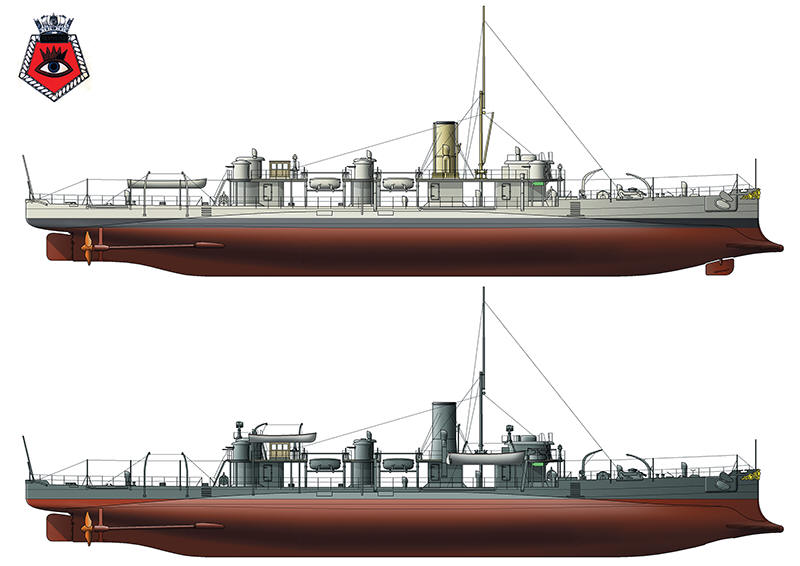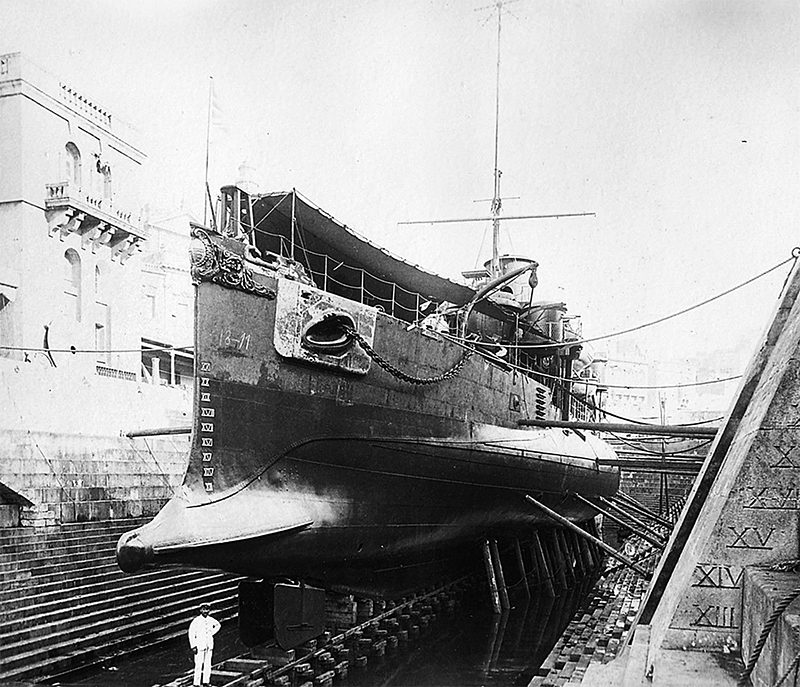

Polyphemus 1882
| Name | No | Yard No | Builder | Laid down | Launched | Comp | Fate |
| Polyphemus | Chatham DYd | 21.9.1878 | 15.6.1881 | 9.1882 | BU 7.1903 |
|
Displacement normal, t |
2640 |
|
Displacement full, t |
|
|
Length, m |
73.2 pp 78.3 wl 80.9 oa |
|
Breadth, m |
12.2 |
|
Draught, m |
6.25 |
|
No of shafts |
2 |
|
Machinery |
2 4-cyl. HC, 10 locomotive boilers |
|
Power, h. p. |
natural draught: 5500, forced draught: 7000 |
|
Max speed, kts |
natural draught: 15, forced draught: 18 |
|
Fuel, t |
coal 270 |
| Endurance, nm(kts) | 1700(10) |
| Armour, mm |
steel; curved deck: 76 |
|
Armament |
6 x 2 - 25/40 Nordenfelt Mk II, 5 - 356 TT (sub, 1 bow, 4 beam, 18) |
|
Complement |
80 |
Project history: This unusual vessel is one of the best known Victorian warships, but for all the wrong reasons. Regarded as a freak designed mainly for ramming, she was in fact a well thought out and combat-worthy design intended chiefly for torpedo attack. Her story can be said to start when Nathaniel Barnaby, the Director of Naval Construction, produced a design for a much larger and faster version of Vesuvius in 1872, before that vessel was even commenced. However when Barnaby finally came to produce the definitive design for Polyphemus the concept had become both larger and more complex. Four broadside submerged tubes were added to the bow tube, and a truly impressive number of reloads were carried. In case the broadside tubes - a new concept at the time - were not the success they proved to be, Polyphemus was given a spur ram so that she could also use ramming as a method of attack. The design documents show quite conclusively that ramming was very much a secondary function, and the old story that she was inspired by Admiral Sartorius' ideas on steam rams is completely false.
To enable Polyphemus to bring her powerful torpedo battery to bear she was not only given the phenomenal speed for her day of 18kts but also was protected by an armoured curved deck of 76mm steel. The basic form of the protected part of the hull was like a cigar, or a submarine, the hull being built up on top of this to give a more conventional, if low-lying appearrance.
It took some time to eliminate the teething troubles of both broadside tubes and boilers, but thereafter Polyphemus was an eminently battleworthy vessel. However, there were few obvious functions for her in a peacetime navy, her main achievement apart from proving the validity of broadside rubes being the famous episode of charging the boom at Berehaven (Ireland) at full speed and spectacularly demolishing it. Gradually the increasing size and range of QF guns made it less likely that she would be able to survive to bring her torpedoes into action (it should be remembered that when she was designed guns heavy enough to pierce her armour were too slow-firing and difficult to train to stand much chance of hitting so fast a ship).
Ship protection: Ship was protected by curved steel 76mm deck.
Modernizations: 1884: reboilered with 8 cylindrical boilers; - 6 x 2 - 25/40; + 2 x 1 - 57/40 6pdr Hotchkiss Mk I, 4 x 4 - 25/40
later 1880th: - 4 x 4 - 25/40; + 4 x 1 - 57/40 6pdr Hotchkiss Mk I
Naval service: No significant events.

Polyphemus

Polyphemus as built and after reboilered (A.Dashyan)

Polyphemus in dock, Malta
© Navypedia, 2020